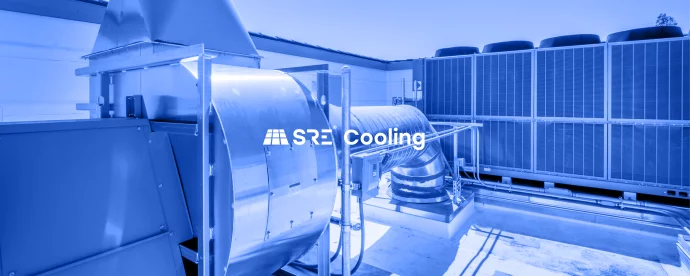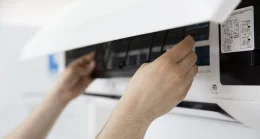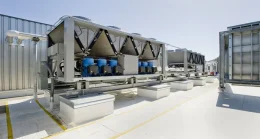How The Right Cooling System Can Prevent Datacentre Downtime
Whether you are running an in-house enterprise server room or colocation datacentre, critical power and cooling are key environmental factors that must be managed to prevent IT system operating errors, erroneous alarm conditions, data processing errors, system malfunctions and unexpected shutdowns.
Thermodynamic airflows are an important aspect to consider when designing a server room or datacentre environment. All electronic devices generate heat and the amount of heat generated by an IT server can greatly impact its operating environment. A typical rack cabinet will typically house more than one server and the greater the number installed, the larger the heat dissipated into the server room or datacentre white space. In a typical datacentre ratings of 15-30kW are no common for a fully loaded server rack cabinet and overall consumption for a server room can typically be up to 200kW and for a datacentre up to several hundred Mega-Watts.
If not managed, any residual heat build-up can reach dangerous levels. This can be within individual server cabinets or ‘hot-spots’ within the overall IT white space. Insufficient airflow can also be a problem for poorly designed environments leading to un-managed temperature fluctuations, poor energy efficiency and the need for additional cooling systems to be added post commissioning.
IT System Cooling
The electronics within a modern server require a large amount of electrical power and this is usually supplied as a direct current (DC) via an internal Switch Mode Power Supply (SMPS) which is itself connected to an alternating current (AC) power sources. Within a critical power environment, servers are usually connected to a server cabinet power distribution unit which is itself connected to an uninterruptible power source.
Cool air is typically drawn into a server via internal fans and is drawn over the electronics circuits. The warmed air is then expelled out of the server case via the fan exhaust system. This arrangement benefits server room or datacentre design as it allows for server cabinet rows to be arranged in a uniform manner and typically in a ‘hot-aisle/cold-aisle’ arrangement. From a cooling system perspective, cool air must be supplied to the front of the server cabinets and rows and taken back into the cooling system from the rear of the server cabinets.
Whilst the fan arrangement within a typical server is sufficient to cool a typical server, the build-up of heat within a confined space like a rack cabinet of two or more servers can be excessive. If this heat build-up is not reduced, temperatures can rise to a point where the servers will fail and potentially pose a fire risk. In some environments, humidity levels are naturally higher than others and increased humidity levels can also cause server room failures, corrosion and rust.
Most IT and other electronic systems can operate up to 40°C and 95% relative humidity without derating these conditions are not suitable for people to work within. For a server room or datacentre environment temperatures of 20-25°C with a relative humidity of 40-55% are recommended. It should be noted that the ASHRAE standard continues to consider raising the operating temperature for server environments to towards 30°C as this would reduce cooling requirements and therefore improve energy usage and overall operating efficiency.
Server Room Cooling Systems
IT facilities run 24/7 and just as they need uninterruptible power to maintain their services and uptime, so must the cooling be 24/7 and uninterrupted. When IT systems are installed in their own dedicated room such as a server room or micro-datacentre, they need to be supported by their own dedicated cooling systems.
As with any critical IT system, redundancy should also be built-into the design, as well as remote monitoring. Redundancy in the design whether N+1 or 2N caters for not only cooling system failure but also the ability to carry out maintenance without interruption to the cooling system(s) and IT system shutdown. Other aspects to consider include:
- Back-up power: if the mains power supply fails will the air conditioners fail or will they be powered via a UPS system or back-up power generator? Best practice is to support cooling systems with a standby generator. Where they are to be powered by the UPS this can lead to an unnecessary over-sizing of the UPS system and its battery.
- Remote monitoring: UPS systems are typically monitored over an IP-network connection or external modem for alarm conditions including mains power failure and low battery. Air conditioners should also be monitored to alert engineering teams for failures and alarm conditions.
- Automatic reset and restart: this is another consideration and one that is vital if the air conditioners are allowed to fail when there is a power-cut. In this scenario, it is also important to consider environment/temperature monitoring systems to alert should temperatures or humidity rise to dangerous levels. If there is no automatic reset or restart function a local engineer will be required. This could lead to long response times and excessive costs if sub-contracted and out of normal working hours.
- Correct sizing, fitting and ventilation: it is not only important to correctly size and install an air conditioning system, but it is also important to ensure correct and sealed ventilation. Worst case scenarios should be explored including any potential to block ventilation piping and outlets or for them to be bring contamination back into the air conditioning system or overall environment.
- Condensation planning: the overall environment may be humid and any person within the IT space will introduce humidity. Air conditioners act as dehumidifiers and if there is any potential for condensation build up or dripping this must be rectified to prevent damage in the form of corrosion or even short-circuits.
- Plan for a failure: a sound business continuity plan will cover failure of the power and cooling facilities. Uninterruptible power supplies have a built-in automatic bypass facility that allows them to safely transfer their loads to mains. Worst case is that the UPS remains in bypass whilst it is being repaired. If an air conditioning fails and the IT systems must be kept running (or cannot be shutdown quickly enough) temporary air conditioning will be required. This can be achieved by building redundancy into the overall cooling design or having portable air conditioners on-site that can be quickly deployed.
- Maintenance Contracts: regular inspections and routine preventative maintenance are important for both sustained and reliable running of installed cooling systems and their efficient operation. Typically, air conditioners may be maintained once or twice a year and should be maintained always by manufacturer certified engineers with any parts replaced with approved parts.
A well designed, installed and maintained air conditioning and cooling system is a key component of any server room or datacentre environment. The right design, installation and maintenance will give you a cooling system that can support your IT strategy and future growth plans.
Whether you are planning a new installation or upgrade or simply want advice on an existing system please contact the Server Room Environments team for a free site survey and project review. Our team can provide references across the UK for a range of environments, installations and building types.


























